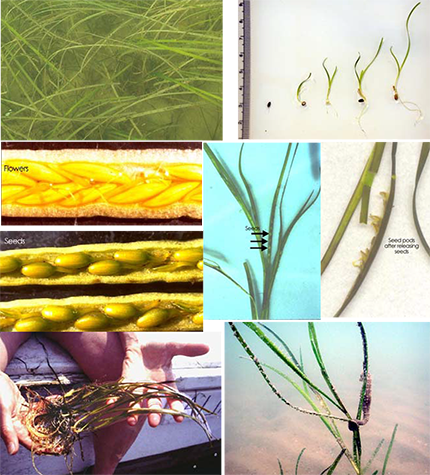Submerged Aquatic Vegetation (SAV) Identification Key
Main_Content
The bay grass key was designed to allow you to identify most species of bay grasses found in Maryland. Although bay grasses are notoriously difficult to identify using standard taxonomic keys, the flexible format of the Internet allows us to combine detailed pictures, simple line drawings and text messages in a stepwise sequence that makes identifying bay grasses simple. You may find it useful to have a clear metric ruler with millimeters marked, a magnifying glass, and a Ziploc plastic bag to help you in the process of identifying your plant.

|
If you already know the identity of a particular bay grass use the drop down boxes below. |
|---|
Common Name:
or
Scientific Name:
| | Common Name: | Eelgrass |
| | Scientific Name: | Zostera marina
|
| | Native or Non-native: | Native
|
| | Illustration: | 
|
| | Link to larger illustration: |
|
| | Printable Version: | |
| | Family: | Zosteraceae |
| | Distribution: | Once one of the most abundant and most persistent bay grass species in the high-salinity portions of Chesapeake Bay and the lower tributaries ranging from the Miles River south to the mouth of the bay. Most eelgrass in Maryland has disappeared due to increasing water temperatures in the bay. Eelgrass can now only be found in Tangier Sound south to the mouth of the bay and in the lower reaches of very high salinity tidal rivers. |
| | Recognition: |
Eelgrass has a thick creeping rhizome 2 to 5 mm (1/16 in to 1/8 in) with numerous roots and a leaf at nodes spaced 1 to 3.5 cm (1/3 in to 1 ½ in) apart. Alternate, ribbon-like leaves with rounded tips arise from these nodes and grow to 1.2 m (4 ft) in length and 2 to 12 mm (1/16 in to 1/3 in) width. Each leaf has a tubular, membranous basal sheath 5 to 20 cm (2 in to 8 in) long and with a width greater than that of the leaf itself. The leaves are relatively small and narrow where the plants grow on shallow, sandy, physically exposed substrates. Longer, wider leaves occur on plants growing on deep, muddy, and exposed areas. |
| | Ecological Significance: | Eelgrass is the only true “seagrass” found in the Chesapeake Bay. Eelgrass occurs along both coasts of the United States, and the Chesapeake Bay is near the southern limit of its distribution on the east coast. Unlike other bay grasses, eelgrass dies back during the warm summer months and grows best in the cooler waters of spring and fall. Eelgrass is an important habitat for blue crabs that use the beds for protective cover during mating and as juveniles. It is also an important habitat for the seahorse, pipefish and speckled sea trout, and important food source for brant geese (which almost disappeared when the eelgrass declined significantly in the 1930's due to the “wasting disease”). Canada geese, widgeon, redhead and black ducks and green sea turtles all feed on eelgrass. Eelgrass also provides a spawning site for some species of fish, and can also reduce coastal erosion by securing the sediment with its roots. |
| | Similar Species: | The basal form of widgeon grass (Ruppia maritima) can be mistaken for eelgrass, though the former has thinner and longer leaves. Eelgrass can also be mistaken for wild celery, and looks so similar that some call wild celery “eelgrass” even though the two are different. |
| | Reproduction: | Eelgrass reproduces asexually and sexually. Asexual reproduction occurs through growth and elongation of the rhizome and by formation of turions. Sexual reproduction occurs through seed formation, and begins with flowering in May and June. Eelgrass is monoecious and fertilization occurs by drifting pollen. Male and female flowers mature at different times on the same plant to prevent self-fertilization. Once fertilized the flowers develop into seed-bearing generative shoots that eventually break off and float to the surface. The shoots then release their seeds as they drift. |
|
|
Center_Content
For permission to reproduce individual photos, please contact Mike Naylor
The text and photos used in this key were produced through a collaborative effort among the following partners.

